ASRock Rack C2750D4I Review: A Storage Motherboard with Management
by Ian Cutress on April 29, 2014 9:00 AM EST- Posted in
- Motherboards
- Storage
- Atom
- ASRock
- Silvermont
- Enterprise
- server
- Avoton
Silverstone was clearly monitoring the forums with regards to the C2750D4I in order to come out with a case designed amound the concept. Our Silverstone contact also became aware that we had the motherboard in for testing and volunteered its DS380 for a quick overview. I installed the motherboard in to the case along with my rag-tag collection of storage drives (four 3TB Seagate Barracuda 7200.14, one 2TB Western Digital Green and one 1.5 TB Seagate Barracuda 7200.11) which were previously spread out across several systems.
The case has a top mounted power-supply section (we used the Silverstone 300W SFF PSU) and places the C2750D4I upside down, with space for an 11” dual slot GPU. For PSUs that have a top/bottom mounted fan, Silverstone’s design means that the airflow for it is out of the case.
The rear of the case has a single 120mm fan installed, and the side of the case (for blowing onto the drives) uses two 120mm fans – all three were included in our retail sample. The fans use a dimpled design to reduce fan noise.
The drive area uses a backplane, and SATA cables from the motherboard attach to this. Users can install SAS drives using both SATA ports.
The case is designed for hot-swap systems, and as such the front eight bays allow the drives to be removed.
The front of the case has two USB ports, with the connector inside capable of being placed in a USB 3.0 header. This is where the case differs in being ideal for the C2750, as there are no USB 3.0 headers on board. Had Silverstone offered this connector as a USB 3.0/USB 2.0 hybrid, this would have been more ideal. There are two audio jacks as well should a user decide to place a different mini-ITX motherboard in the case and can take advantage of eight drive bays via an expansion card.
The front of the case is also lockable, although the key design is not a unique one. It does stop little ones pulling a drive out however.
The case is not a tool-less design, but a standard screwdriver is all I needed to put the system together. Because the C2750D4I has a small heatsink, cable management was easy enough, although the placement of the 24-pin ATX power connector meant that the cable had to go all the way across the motherboard. At the top we also have the 4 bays for 2.5” drives:
Silverstone suggested the 300W PSU that we used for the build, but if a PCIe device was installed we would have had to have used a 24-pin extension cable. Similarly, the SATA cables suggested had a small issue on the bottom SATA port:
Using my own ears (unfortunately I am not equipped to measure audio performance), the three fans installed, when active, were audible enough to disturb quiet scenes in a movie and you might not want it nearby overnight, but certainly silent compared to my normal PC or the busy road I live next to. Temperature readings from the CPU gave 40ºC at idle and 53ºC at load. Total power draw, at the wall with my drives installed using the 300W PSU on a 240V line was 52 W at idle.
Ganesh also has this motherboard in to test and will be examining the storage performance in due course.
| Silverstone DS380 | |
| Price | Link |
| Model Name | SST-DS380B |
| Material | Aluminium door, SECC body |
| Motherboard Size | Mini-ITX, DTX |
| Drive Bays |
8 x 3.5"/2.5" Hot Swappable 4 x 2.5" |
| Cooling |
1 x Rear 120mm 1200 RPM 22 dBA 2 x Side 120mm 1200 RPM 22 dBA |
| Expansion Slots | 2 |
| Front IO |
2 x USB 3.0 1 x Headphone 1 x Microphone |
| PSU | SFX |
| Expansion Card | 11" x 4.38" |
| CPU Cooler | 57 mm |
| Dimensions |
211 mm x 285 mm x 360 mm 21.6 liters |
| Warranty Period | 1 Year |
| Product Page | Link |




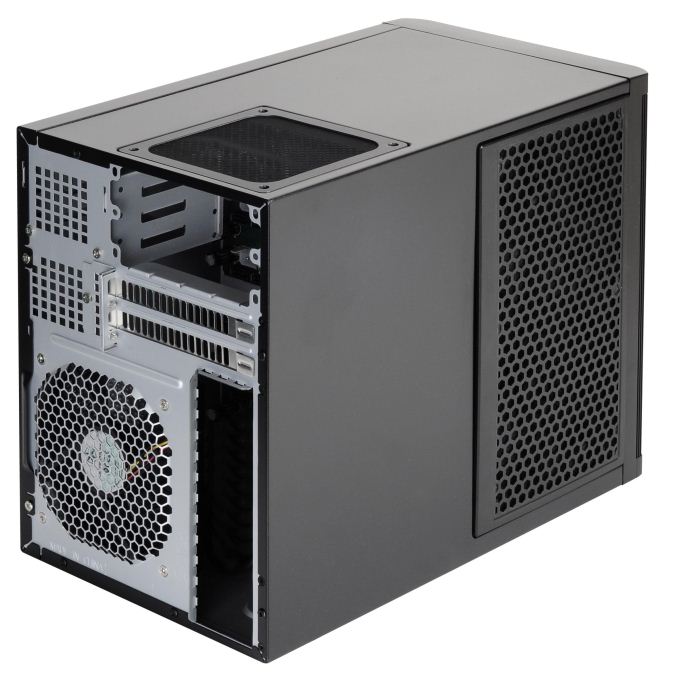
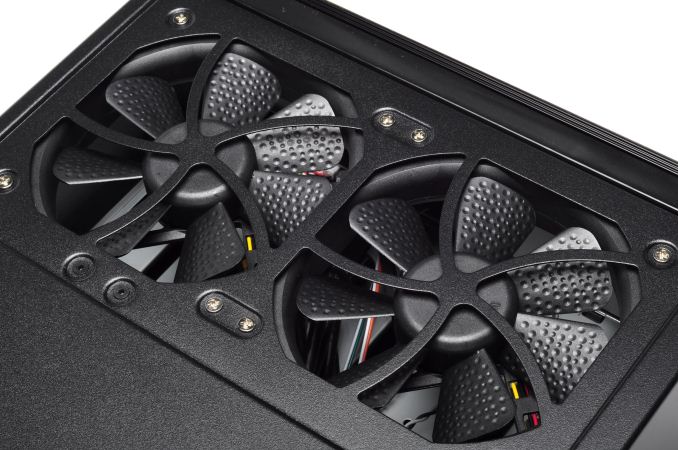


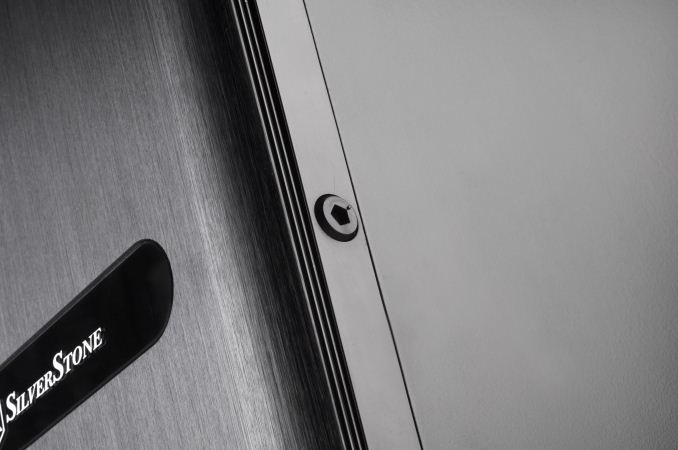
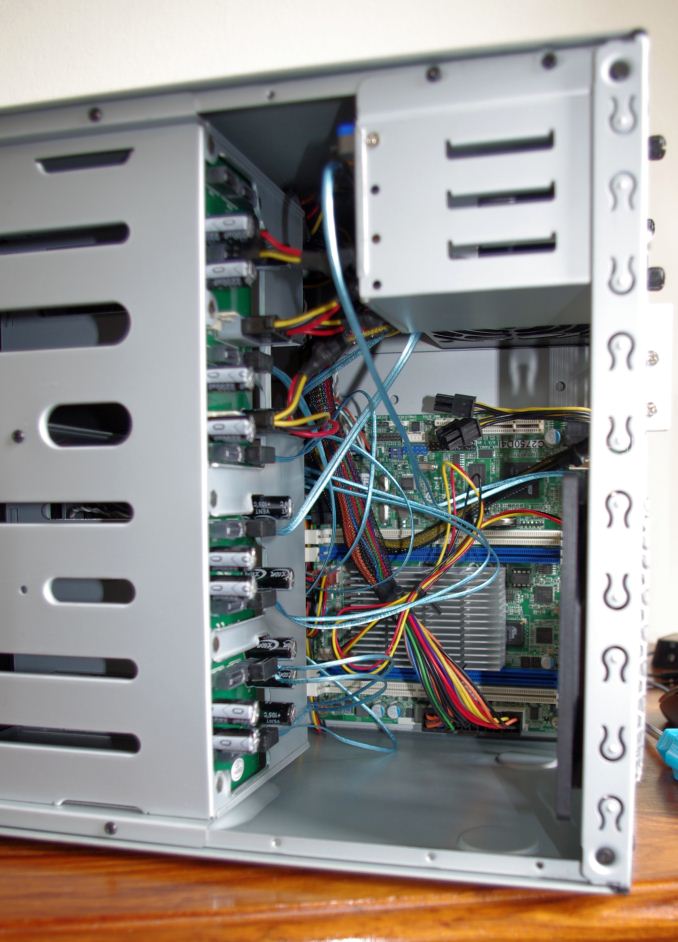
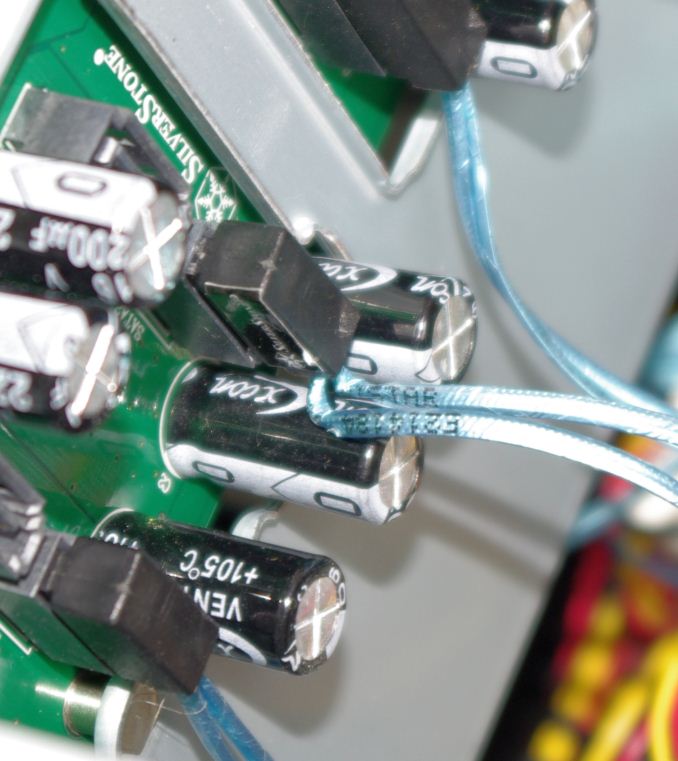














85 Comments
View All Comments
chekk - Tuesday, April 29, 2014 - link
Yes, for that price and target market, they should have gone with an LSI chip. You don't see Supermicro or Tyan boards in that price range using Marvell.cen - Tuesday, April 29, 2014 - link
I know it was said that the actual storage review is coming in the future but I think this article is a complete waste of time. You should simply let the storage review happen and not bother with this at all. More than half of the benchmarks are useless, the only ones of value might be encryption and compression.What we actually want to see is FreeNAS thrown in there with a 16TB ZFS zpool and some IO benchmarks. :)
Calista - Tuesday, April 29, 2014 - link
Could be perfect for anyone wishing to build a tiny box for virtualization, a task in which many a NIC, plenty of RAM and a multicore processor is most helpful.RandomUsername3245 - Tuesday, April 29, 2014 - link
I've wondered how one of these Avoton boards would compare to a Supermicro C2xx + Pentum G3430 (which supports ECC). This is the cheaper option if you don't need lots of ports, but once you add $100 for a sata card from Ebay, these options are similarly priced.Calista - Tuesday, April 29, 2014 - link
Could you please measure power consumption without the 770 as well? I have a HP Elite 8200 with a quad i5, SSD + 2.5" HDD, 32 GB RAM and an extra NIC as a makeshift box for ESXi and with 6-8 virtual machines running it draw less than 30 watt. It would be interesting to know how low this machine could go since any machine running 24/7 will add substantially to the power bill.Guspaz - Tuesday, April 29, 2014 - link
If I was using this in my home file server, I'd make a few changes to the board. The number of SATA ports is fine, because even though I've got 18 drives in mine, that PCIe slot lets you put in a SAS/SATA controller to get the total up as high as needed (16 port cards aren't hard to find, higher is available).However, I'd change a few things:
1) Replace the CPU. Home file servers can often be bottlenecked by individual CPU core performance, because not all filesystem operations on ZFS are multithreaded (although it's far better these days). For the ~25W TDP, I would much rather have a Haswell part, even if it meant fewer cores. For that TDP, you could get a ~3GHz dual-core part, or a ~2GHz quad-core part. Either of those would be better suited.
2) Add digital video output. HDMI, DVI, DisplayPort, any of them. I'm not suggesting using this thing for HTPC use, but many monitors these days are digital-only, and nothing is more annoying than trying to diagnose problems with a headless system when your motherboard is VGA-only and all you have is digital-only monitors.
3) Drop two of the RAM slots, and use them for another PCIe slot. Four slots is excessive for anything but enterprise use. Two slots cheaply gets you 16GB of RAM, or 32GB if you're desperate, either of which is more than enough for a home file server. A second PCIe slot, on the other hand, could enable a variety of other options, be they multiple SAS/SATA cards, a discrete video card if you really do want to use the thing as an HTPC, a video capture card (this board in that Silverstone case would probably make a decent HD-SDI recording box), etc.
4) More USB ports, prefereably 3.0. If extra space is needed for the ports, ditch one of the three GigE ports; two is plenty.
5) An mSATA slot for a boot drive could be useful, although it would probably increase board complexity by requiring some of the board components to move to the rear.
stoatwblr - Thursday, May 1, 2014 - link
"Two slots cheaply gets you 16GB of RAM, or 32GB if you're desperate"My ZFS media rig has 19 drives (21 including the ZIL and l2arc), plus boot media and at 36Tb it _needs_ 32Gb of ram to work efficiently. It kept bottlenecking at 16Gb. The next round of storage will push well past the 32Gb requirement.
+1 on the video output, +1 on usb3 - but I don't think it needs more ports. That's not a good fit for the target, which is a storage controller. Ditto on the mSATA.
If you need fewer cores there's a quad-core version which is cheaper.
I'd prefer that they placed a lsi sas controller onboard and dumped the sata ports for minisas (an expander cable is cheap, tidy and positively locks into place to ensure no problems.) The downside is that a decent sas controller would add at least $100 and a port multiplexer as much again.
If I was designing, I'd think about 10Gb copper, but that adds 15W to the power consumption and $150 to the price.
This thing is expensive for prosumers and limited for enterprise, but compromises are always like that. Supermicro's version has similar issues and the fact that they don't use minisas makes me think that perhaps Intel have placed restrictions on what can be used.
bernstein - Thursday, May 1, 2014 - link
well my zfs rig has 20 2.5" 2tb sata hdds (2x 16tb raidz2). no ZIL. no L2ARC.runs on a single 8GB ecc ddr2 dimm on a sandy bridge i3-2100T.
as a home fileserver this system rocks. it might be ram "bottlenecked" for high i/o tasks, but all i can see is that it performs at least as well as a single USB3 hdd... and it outperforms any consumer nas.
Daniel Egger - Tuesday, April 29, 2014 - link
For a NAS or SAN build this seriously lacks 10GbE and USB 3 ports. All in all this board seems like a pretty strange amalgamation of random features, as there're better choices for about any possible use case around.Gunbuster - Tuesday, April 29, 2014 - link
14000 RPM Delta fans? No Thanks!I would have called it the AssRack. Sorry I couldn't resist!